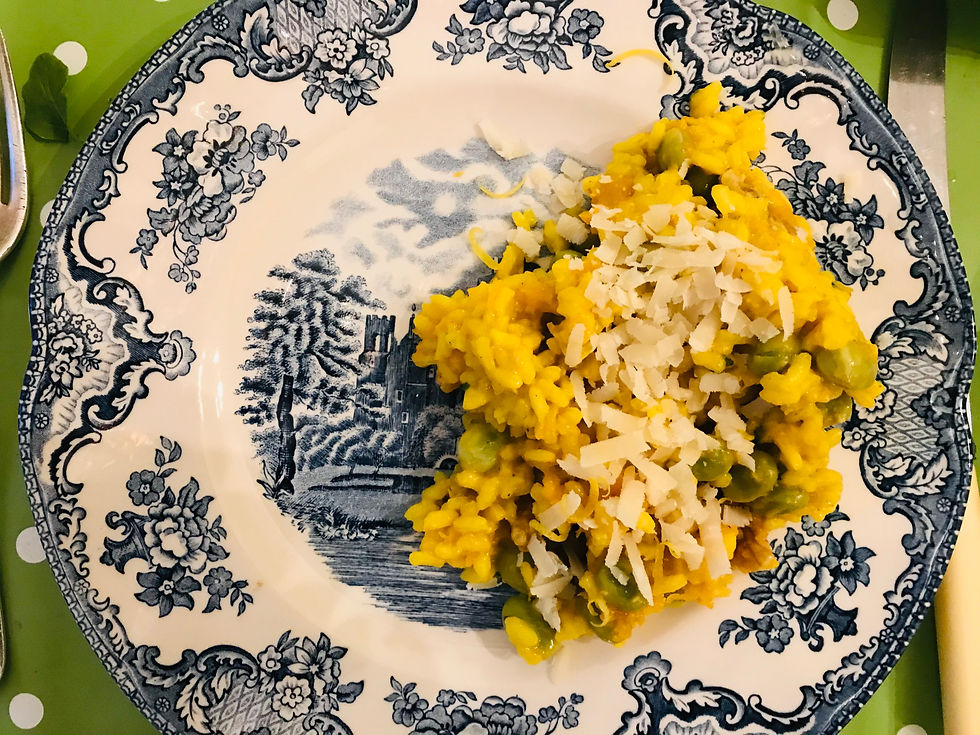Herefordshire Sole Food
- riotactuk
- May 21, 2021
- 4 min read
Updated: Jul 9, 2022
After a year in lockdown, I recently managed to make it to the rural periphery of Herefordshire; to see old friends after too long and to once again appreciate the countryside. I wasn't disappointed. In between trudging around pastoral parishes and bemused by the sight of the "townie" feeding chickens, I managed to get in some cooking.

This recipe is one that flows organically from what was in the larder and/or fridge. But. it was also given that extra little oomph by the local treats of the village of Almley, such as being able to forage wild garlic in the woods.
The risotto served as an accompaniment with this meal is undoubtedly a vegetarian dish that can be served as a meal in its own right. Simply upscale the portions appropriately.
This recipe serves 2 to 3 diners. Do your own maths if you want it otherwise
Shopping list
Filleted lemon sole; 1 to 2 fillets per diner
500ml vegetable stock or 1 to 2 stock cubes/jellies diluted in the equivalent liquid
Extra virgin olive oil
A generous knob of butter
1 cup of arborio (risotto) rice
½ a butternut squash
1 cup of broad beans; frozen or fresh; steamed or blanched
1 handful of walnuts; roughly broken using pestle and mortar
Parmesan (or grana padano) cheese to taste
2 to 3 cloves of garlic; crushed or grated
1 large onion, finely cubed (optional)
½ cup of foraged wild garlic flowers (optional)
125ml white wine
A little finely milled almond flour
A variety or green leaves
1 endive (chicory)
Balsamic vinegar (or fig vinegar)
Fresh lemon zest (optional)
The juice of half a lemon
A clutch of chives, finely chopped
A few saffron stamens
½ teaspoon of turmeric
Seasoning; black pepper, salt and a bay leaf
Cooking method
the risotto
I'll try not to rant about the abuses to butternut squash here. Here is all you need to know about cooking this sublime vegetable. Otherwise. simply cut the ½ in half; (scraping out the pips and sinews if you're cooking that bit). Drop into a pot of boiling salted water and cook for approx. 15 mins; until tender so that a fork easily passes through the flesh. Once cooked, drain in a colander
In the interim, heat the vegetable stock or boil the kettle and dilute the stock cube/jelly in approx. 500ml of hot water
In a deep saucepan, heat a little extra virgin olive oil, adding the garlic and cubed onion (if using) once the oil is hot. Allow them to brown before pouring in all the rice. Stir continuously to ensure that it's coated with the oil
Pour in the vegetable stock. Stir and bring to the boil. Allow to boil vigorously for 7 to 10 mins, stirring occasionally. Cover, reduce the heat and allow to simmer for another 10 to 15 mins, adding the seasoning halfway through
When the majority of the liquid has been absorbed, remove from the heat and allow to rest for about 10 mins. (Yes, this is a different method from the dominant recipes that favour continuous cooking. I was taught it by a vehement Milanese lady, the mother of a friend, and I have never looked back). This will allow the rice to absorb a lot of the liquid
Return to the heat, adding water, bit-by-bit, so that it neither sticks nor becomes too dry
Add half of the white wine and allow the rice to simmer, boiling off the booze. Keep cooking and stirring until the rice is al dente, but fully cooked. If you favour the so-called "wet style" reputedly the style in Venice, go for it. Otherwise reduce until it is succulent and moist, but not too wet
About five mins before serving, add the cubed cooked butternut squash, broad beans and broken walnuts. Gently fold into the rice so that they all heat evenly, taking care not to "mash" the butternut squash too finely
Plate and serve with grated Parmesan (or other cheese) to taste

the salad
Mix your chosen leaves into a salad bowl (or individual salad bowls), breaking the endive into large pieces and mixing together the leaves
Dress with extra virgin olive oil (or walnut oil), balsamic vinegar (or fig vinegar). Dress with freshly grated lemon zest (optional)
the fish
Heat a little olive oil in a shallow pan on a high heat
Squeeze a little lemon juice over all of the uncooked lemon sole fillets. Making use of this liquid coating, dip each side of the fillets into a dusting of (almond) flour sprinkled on a plate or board. Once coated, place in the frying pan
While cooking, add the dried or fresh wild garlic flowers to the pan
Cook for no more than a couple of minutes on either side. Plate and serve.

The sauce
Add a generous knob of butter to a small saucepan on a high heat.
Once the butter begins to bubble, add the juice of half a large lemon and the remainder of the white wine. The mixture is unlikely to mix easily and prone to curdle, so needs constant stirring as it reduces
Once the mixture has reduced by half, add the chives and continue to stir
Add salt and black pepper
Pour into a sauce dish and take to the table so that it can be spooned on to taste by diners











Comments